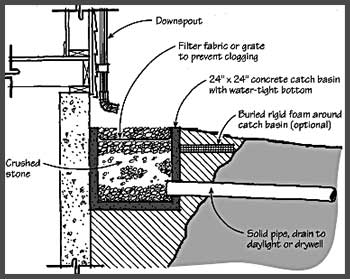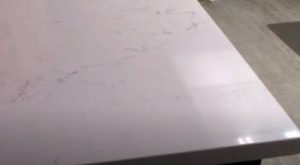The battle between daylight drain and sump pump has been ongoing for years. Homeowners often face the difficult decision of choosing the best method to protect their homes from water damage.
In this article, we will discuss the pros and cons of both daylight drains and sump pumps, helping you make an informed decision on which solution is best for you.
A Brief Comparison Table
| Feature | Daylight Drain | Sump Pump |
| Function | Redirects water using gravity and natural slope | Actively pumps water out of sump pit |
| Terrain Suitability | Requires natural slope | Works on any terrain |
| Energy Efficiency | No electricity needed | Requires electricity |
| Maintenance | Low maintenance | Regular maintenance needed |
| Noise | Quiet operation | Can be noisy |
| Effectiveness | Limited during heavy rainfall or rapid snowmelt | Highly effective, handles large volumes of water |
| Vulnerability to Power Outages | Not affected | Vulnerable, may need backup power source |
| Installation Cost | Generally lower | Can be higher, especially with backup power |
| Ideal for Surface Water Issues | Yes, especially French drain | Not typically designed for surface water |
| Ideal for Basement/Crawl Space Flooding | Limited effectiveness | Very effective |
Pros and Cons of Daylight Drains

Pros
- No electricity needed: Daylight drains rely on gravity, making them energy-efficient and environmentally friendly. They operate without the need for electricity, which means lower utility bills and no concerns about power outages.
- Low maintenance: With fewer mechanical parts, daylight drains generally require less maintenance than sump pumps. They are less prone to clogging and malfunctions.
- Quieter operation: Since there’s no pump involved, daylight drains operate silently. You won’t have to worry about the noise that sump pumps can sometimes produce.
Cons
- Slope-dependent: For a daylight drain to work effectively, your property must have a natural slope or grade. Homes built on flat land may not benefit from this type of drainage system.
- Limited effectiveness: Daylight drains can struggle to keep up with heavy rainfall or rapid snowmelt, making them less effective than sump pumps in certain situations.
- Possible erosion: Discharging water at a single point can lead to erosion and damage to your landscaping.
Also Read: Problems With Form-A-Drain.
Pros and Cons of Sump Pumps

Pros
- Highly effective: Sump pumps can handle large volumes of water and are suitable for homes prone to flooding or with high water tables. They provide a reliable means of water removal, even during heavy rainfall.
- Works on any terrain: Unlike daylight drains, sump pumps don’t depend on the slope of your property. They are suitable for homes on flat land or with insufficient grade for gravity drainage.
- Automatic operation: Most sump pumps have a float switch that triggers the pump when water levels rise, providing automatic and continuous protection against flooding.
Cons
- Electricity-dependent: Sump pumps rely on electricity to function, making them vulnerable to power outages. To avoid this issue, a battery backup or generator may be necessary, adding to the overall cost.
- Regular maintenance: Sump pumps require regular maintenance, such as cleaning the pit, inspecting the pump, and checking the discharge line, to ensure proper operation and prevent malfunctions.
- Noise: Some sump pumps can be noisy, especially when they cycle on and off frequently. This may be a concern for homeowners with living spaces near the sump pit.
Analyzing the Choice Between Daylight Drains and Sump Pumps
Now that we’ve discussed the pros and cons of both daylight drains and sump pumps, it’s essential to understand how to choose the best option for your specific situation. Here are some factors to consider:
- Property Terrain
One of the most critical factors to consider is your property’s terrain. As mentioned earlier, daylight drains rely on the natural slope of your land to function effectively.
If your property has a suitable slope, a daylight drain might be the better option, as it is energy-efficient and low-maintenance.
On the other hand, if your property is flat or has an insufficient grade for gravity drainage, a sump pump will be the more appropriate choice. Sump pumps are not dependent on the slope of your land and can effectively remove water even in flat areas.
- Water Source and Severity
The severity and source of water issues around your home will also affect your choice. If you’re dealing with surface water problems, a French drain (a type of daylight drain) can effectively collect and redirect the water away from your home.
However, if you have water seeping into your basement or crawl space due to a high water table or excessive rainfall, a sump pump will be more effective. Sump pumps are designed to handle large volumes of water, making them an ideal solution for homes prone to flooding.
Here is how a sump pump works!
- Climate
The local climate can also influence your decision. If you live in an area with frequent heavy rainfalls or rapid snowmelt, a sump pump might be the better choice.
Sump pumps are capable of handling large amounts of water quickly, providing reliable protection against water damage.
On the other hand, if you live in a region with a moderate climate and less frequent heavy rainfall, a daylight drain might be sufficient to manage water around your property.
- Maintenance and Energy Considerations
As discussed, daylight drains require less maintenance than sump pumps and do not rely on electricity to function. If you prefer a low-maintenance, energy-efficient solution, a daylight drain may be the better choice.
However, if you’re willing to invest in regular maintenance and don’t mind the electricity usage, a sump pump can provide a reliable and robust solution for water management.
Also Read: Differences Beween Pipe Bursting And Pipe Lining.
Frequently Asked Questions (FAQ)
A better alternative to a sump pump depends on your specific situation. If your property has a natural slope, a daylight drain may be a more energy-efficient and low-maintenance option. However, if your property is flat or has a high water table, a sump pump may be the better choice. In some cases, a combination of both systems can provide the best protection against water damage.
The choice between a sump pump and a French drain depends on your property’s specific needs. A French drain is a type of daylight drain that collects surface water and directs it away from your home using a sloped trench filled with gravel and a perforated pipe. If your primary concern is surface water and your property has a suitable slope, a French drain might be the better option. However, if you have water seeping into your basement or crawl space, a sump pump may be the more effective solution.
A sump pump is an electric-powered device that removes water from a sump pit and discharges it outside your home. A drain tile, on the other hand, is a type of daylight drain system that consists of a perforated pipe installed around your home’s foundation. It collects excess water and directs it away from your home using gravity. Sump pumps are typically used for active water removal, while drain tiles help prevent water from accumulating near the foundation in the first place.
Whether you need a drain and sump pump depends on your specific situation. If your property has a natural slope and you’re dealing with surface water issues, a daylight drain or French drain may suffice. However, if you have a high water table, frequent basement flooding, or live in an area with heavy rainfall, a sump pump might be necessary. In some cases, a combination of both systems can offer the best protection against water damage.
New homes often have sump pumps because modern building codes require proper water management systems to prevent flooding and water damage. A sump pump provides an effective solution to manage water that seeps into basements or crawl spaces due to high water tables, heavy rainfall, or poor drainage. Installing a sump pump in a new home is a proactive measure to ensure the homeowner’s peace of mind and protect the property from potential water damage.
Conclusion
In conclusion, the choice between daylight drains and sump pumps depends on several factors, such as your property’s terrain, water source and severity, climate, and personal preferences regarding maintenance and energy efficiency.
Both systems have their pros and cons, so carefully consider your specific situation to make an informed decision. In some cases, a combination of both systems can provide the best protection against water damage and give you peace of mind knowing your home is safe and dry.



